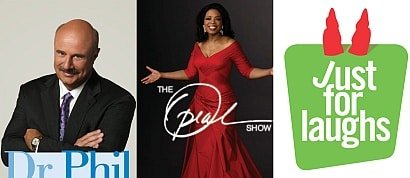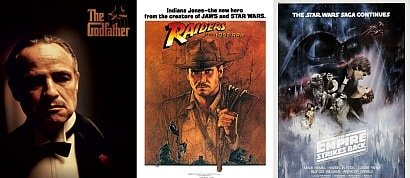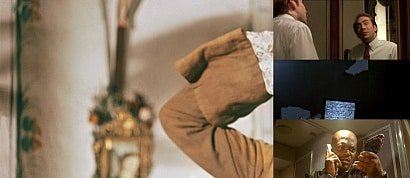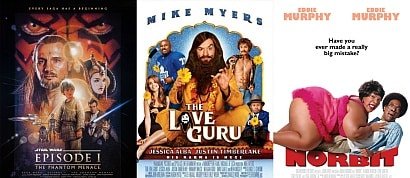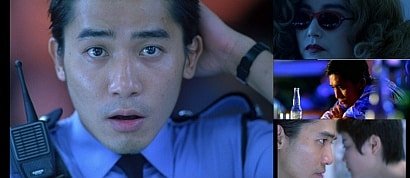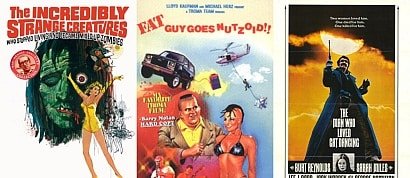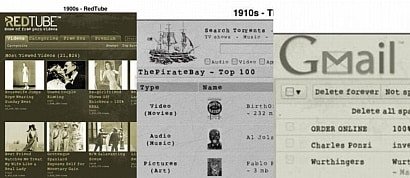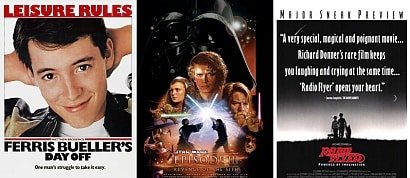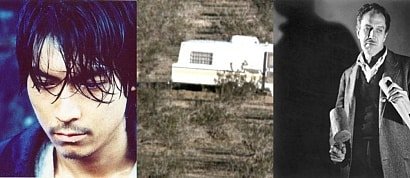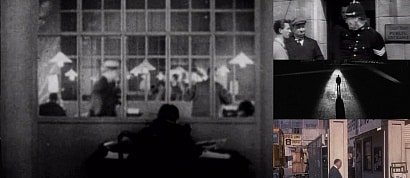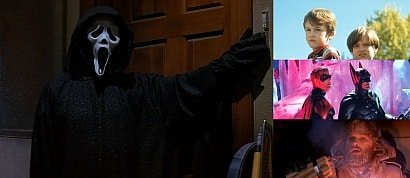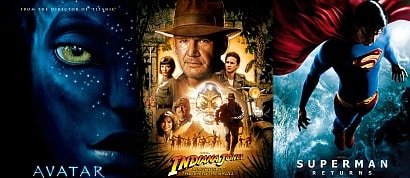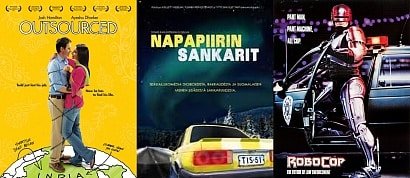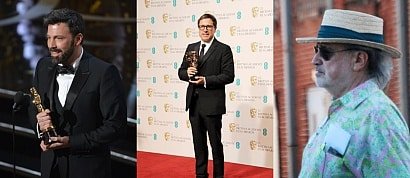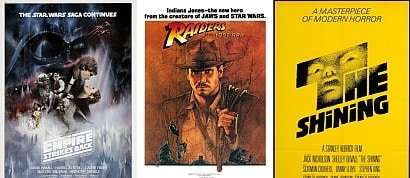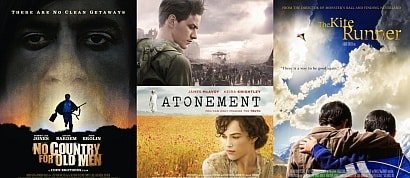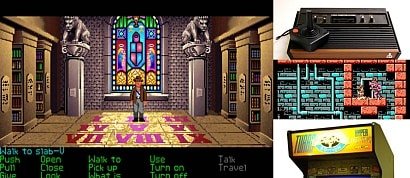The history of CGI
Sort by:
Showing 17 items
Decade:
Rating:
List Type:
Westworld (1973)
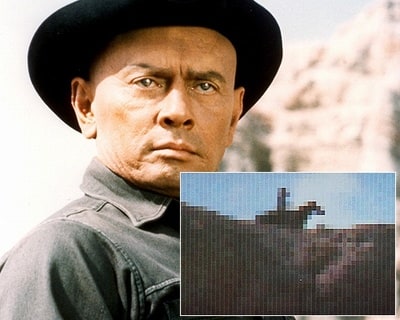
Note : Yul Brynner plays a gunslinging android in Michael Crichton’s ‘70s sci-fi Western – think the terminator crossed with an evil Shane – a film notable too for being the first major motion picture to use CGI. Brynner’s robo-vision, a pixelated POV digitally processed by computer graphics whizzes John Whitney Jr. and Gary Demos of Information International, Inc. (better known as ‘Triple-I’ or ‘III’), was truly revolutionary. According to our sources, each frame of footage was color-separated and scanned so it could be converted into rectangular blocks, then colour was added to make a coarse pixel matrix that could be output back to film. Presto, infra-red androidvision. Simple really, when you think about it.
johanlefourbe's rating:


Futureworld (1976)

Note : Westworld was not just influential, it also inspired a sequel. Futureworld, in which more terror droids are unleashed, this time into a Crystal Maze-like future zone, gave Triple-I the chance to push the CG boundaries even further. This time they gave audiences a first glimpse of 3D. No whizzy glasses were required to see Peter Fonda’s head and hand rendered into three dimensions – only a few seconds of the Fonda bonce actually appeared in the film – but creating the images was a seriously painstaking process. Their hard work was recognised by the Oscars a decade later with a Scientific & Engineering Academy Award. Now, if only that whole 3D malarkey had worked out.
Star Wars (1977)

Note : Like Bernie Mac, Baby Face Nelson and the giant barbecue rib, 3D graphics were born in Chicago. That was thanks largely to computer animation boffin Larry Cuba who toiled away for months on the city’s University of Illinois campus to match George Lucas’ idea for the pre-Death Star attack briefing. What he came up with was a wireframe mock-up the Empire’s moon-shaped HQ that made the Rebel Alliance’s IT department look seriously good. A special making-of feature that's well-worth ten minutes of your time, gives a fascinating behind-the-screens look at how his wireframe work came together. Ridley Scott called on similar wireframe technology for Alien’s LV-426 fly-over two years later, but it was Cuba, a true pioneer of CGI, who got the ball rolling. Most impressive, as a certain ex-Jedi might say.
johanlefourbe's rating:


TRON (1982)

Note : Steven Lisberger’s sci-fi was seminal because it didn’t so much push back the boundaries of CGI as ramraid them with a light cycle, and it did it using a computer that boasted – wait for it – 2Mb of memory. To put into context, that’s about 1/2000th of the capacity of your average PC. Despite the constraints Lisberger and co. were working with, they conjured entire CG sequences in Tron World, more than a quarter of an hour’s worth of digital effects in total, including the 3D light cycle race that streaked across our subconscious in a neon blur. Triple-III, the CG pioneers of Westworld, were called in to realise Syd Mead’s designs for Sark’s ship and the solar sailer.
johanlefourbe's rating:



Note : In 1984, a gifted young Lucasfilm employee was given the chance to work on a scene in Barry Levinson’s detective romp Young Sherlock Holmes that, for the first time in cinema history, aimed to blend CG and live-action seamlessly. For John Lasseter the experience constructing the movie’s stained glass knight was formative, ILM boss Dennis Muren’s collaborative approach defining his own approach at Pixar and Disney. “The room was always open for discussion, and Dennis really listened to everybody,” Lasseter reflects on Muren’s dailies sessions every morning. For Muren, the technique – real-life models that were then painstakingly digitised – was frustrating, but revolutionary: “You could design the thing exactly the way your mind conceived it. It was really great being there, working on it with the pioneers of that whole process. The stuff really stands up today.” The Academy agreed – Young Sherlock adorned 221B with an Oscar for Best Visual Effects.

Note : This gleeful one-minute short about a giant-honked android and his buzzing nemesis was technically a Lucasfilm, but, for all intents and purposes, it was Pixar’s first animation. With it John Lasseter pushed yet more CG boundary. Working under the auspices of George Lucas’ Computer Graphics Project, his team pioneered animation’s first use of motion blur, a significant breakthrough, while taking a big step towards Pixar’s modern-day fluidity by abandoning geometric form for a much curvier palatte of shapes. “I was playing with the teardrop shape,” Lasseter remembers, “ and I just started envisioning this fat bumblebee with these gigantic water balloon-like feet hanging from him and big stainless-steel stinger.” Lasseter and his Pixar-ites would soon break away from Lucasfilm, but this was a vital piece in the Pixar puzzle that informed the goal it would come to hold dear: the perfect marriage of art and technology.
johanlefourbe's rating:


The Abyss (1989)

Note : To create cinema’s first CG computer water effects, The Abyss’ worm-like subsea pseudopod, effects guru Phil Tippett pointed James Cameron towards George Lucas’ ILM. Work on the 75 second sequence was ultimately divvyed up between seven different FX houses, with ILM taking on the bulk of the work and designing a program that could simulate the watery beast-tube-thing with incredible realism. The whole process took more than six months – the set had to be photographed from every angle so the effects could be composited onto the live-action – which delayed the film’s release, but it was worth waiting for. Another Oscar winner.
johanlefourbe's rating:


Jurassic Park (1993)

Note : Empire voted Jurassic Park’s first glimpse of those ginormous, tree-munching Brachiosauri as its 27th most magical moment in cinema history. It was a breathtaking reveal: physically textured dinosaurs so realistic it felt like they might come pounding out of the screen. Again, Lucasfilm’s ILM division provided the Oscar-winning visual effects wizardry. The CGI was bleeding edge, but the studio also used a smorgasboard of physical effects on the movie: of 14 minutes of dinosaurs in Jurassic Park, only four minutes were entirely computer generated. Along with the CGI, animatronics and stop-motioned miniatures were used to create the thunderous Gallimimus stampede, and a computer-generated stunt double created for the first time (he was munched by the animatronic T-Rex). Perhaps the movie’s effects DNA – Lucas’ CGI mingling with stop-motion of the kind pioneered by Ray Harryhausen and the animatronics Stan Winston helped developed – explains why Jurassic Park remains magical to this day.
johanlefourbe's rating:


Toy Story (1995)

Note : The first ever full-length CG feature, Toy Story was a mighty undertaking undertaking with a team of animators less-than-mighty in number. 27, in fact. “If we’d known how small our budget and our crew was”, remembers writer Peter Docter, “we probably would have been scared out of our gourds. But we didn’t, so it just felt like we were having a good time.” Up to that point Pixar’s longest CGI animation had been Tin Toy, a full 80 minutes shorter than Buzz and Woody’s first outing. The challenges were compounded by a seriously inexperience crew (half hadn’t even used computers before) and Disney’s budget constraints. It was enough to have Rex cowering in terror, but Pixar came through, again mingling super-detailed animation with emotional beats. Bill Reeves, Toy Story’s supervising technical director, looks back on the experience with pride: “To this day, it’s the hardest, most exhausting, and still most fun I’ve ever done at Pixar. We were essentially kick-starting an industry in terms of CG films.”
johanlefourbe's rating:


Starship Troopers (1997)

Note : A box-office flop weighed down by its $100m+ budget, Paul Verhoeven’s sci-fi war movie was the first film to feature a large-scale CGI military battle. It was also nominated for a Best Visual Effects Oscar, which it might just have won were it not for Titanic’s sailaway success that year. Over 300 artists and technicians were hired to digitally breed that icky strain of alien bug warrior, and those CG designs still hold up today helping enshrine Starship Troopers as cult viewing. The VFX team went on to the likes of I, Robot, King Kong and most recently sci-fi thriller Skyline. Some filmmakers have tried, and failed, to replicate its iconic battle scenes; others, like Peter Jackson on Lord Of The Rings, Zach Snyder’s 300 and Ridley Scott’s Kingdom Of Heaven all struck CG gold, each benefitting from the steps first made here.
johanlefourbe's rating:


Titanic (1997)

Note : The most expensive film of its time, commanding a hefty budget of $200 million, James Cameron’s Titanic required over 500 visual effects shots to recreate one of the biggest disasters of the 20th century. Not only were the fundamental pieces of the ship – the hull, boiler room and boat deck – generated by computers, but major advancements were made in the depiction of flowing water that allowed the audience to immerse themselves in the illusion of a watery grave. More than four studios were reportedly involved behind the scenes, tasked with the meticulous nature of wire removal for flying objects and falling people, and the eventual grand-scale destruction of the ship. It was good enough to fool Davy Jones himself.
johanlefourbe's rating:


Fight Club (1999)

Note : We’d be impressed if you remember this film for its use of photogrammetry, and double points if you actually knew what the word means. It's the method of measuring objects using photographs, and its emergence in Fight Club was an important step towards finding a balance between CGI and storytelling. Most notably applied in architecture, engineering and geology, its practical use in film was uncovered by David Fincher when he looked to solve a common filmmaking problem. The story goes that in the ‘kitchen explosion’ scene Fincher wanted to avoid the camera being seen in the reflection of the stove as it passed over. Instead wire-frame 3-D models were rendered from photographs to map and recreate the set seen in previous shots. Not exactly a straightforward solution.
johanlefourbe's rating:


The Matrix (1999)

Note : The Wachowski brothers and their VFX supervisor John Gaeta looked east to help inject The Matrix with its hyper-real action beats. Akira director Katsuhiro Otomo’s view-morphing techniques were a major influence on the movie. Multiple cameras, CG and wire work-driven motion played with viewers perceptions and created the rotating, slow-motion bullet-time: a full-throttle extension of traditional time-slice photography. Helping with the wire work was Hong Kong action cinema choreographer Yuen Woo-ping – a veteran Jackie Chan and Jet Li collaborator whose martial arts whirlwind Fist Of Legend had caught the Wachowski’s eye – who also enhanced the Oscar-winning effects team create Neo’s suspended, airborne kung fu fights.
johanlefourbe's rating:



Note : Cinema’s first near-photorealistic character wasn’t Gollum or The Polar Express’ conductor, but Dr Aki Ross, the heroine of Hironobu Sakaguchi’s entirely CGI sci-fi. She was rendered in incredible detail – down to the 60,000 hairs on her head – in a production process that took four years and cost nearly $150m. It was a painful process (the 141,964 frames each took an average of 90 minutes to render) and a revolutionary one (early shots had to be redone as the advancing technology allowed for extra detailing), employing a crew of 200 and a render farm in Hawaii boasting nearly a thousand Pentium workstations. To give an idea of how far technology had come in 19 years, the final animation represented 15 terabytes of memory. In 1982, Tron’s effects were created on a computer with 0.0000019 terabytes. Sadly, audiences didn’t much care for the end product: it was a flop so catastrophic it sent its studio, Square Pictures, to the wall.
johanlefourbe's rating:


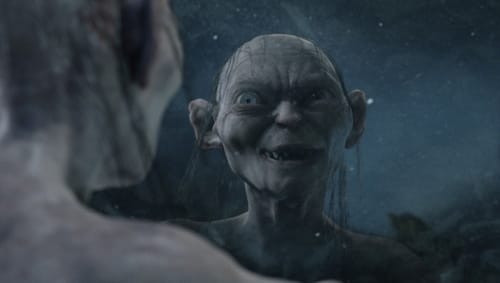
Note : With Avatar and District 9 now behind it, Weta Digital has joined Pixar and ILM at the bleeding edge of CG special effects, but it was Peter Jackson’s Tolkien epic that got the ball rolling. Thanks to Andy Serkis’ remarkable performance and Weta’s digital effects team, Gollum became the first motion-captured CG character to interact directly with other actors. Traditional animation techniques, including rotoscoping and keyframing, were used to replace Serkis’s face with Gollum’s after Jackson decided against making Gollum an entirely CGI character. “We have little piece of Gollum in the first film,” says Jackson, “little teasing the blips of Gollum in the mines. That was our R&D kind of prototype Gollum. We basically threw him away at the beginning of this year because we were able to do so much better. We rebuilt Gollum from scratch – using new software that had been written, new software that our guys had written – and improved him a lot.” LOTR was also notable for its MASSIVE software (acronym boffins will know it better as ‘Multiple Agent Simulation System in Virtual Environment’), which generated artificial intelligent CG orcs by the thousands, lending its epic battles serious levels of realism.
johanlefourbe's rating:


The Polar Express (2004)

Note : While the debate over performance capture rumbles on, at least in some sections of Hollywood and at Meryl Streep’s house, its journey into the mainstream began with Robert Zemeckis’ chilly choo-choo adventure. Zemeckis, whose digitised box of tricks injected Forrest Gump, Zelig-like, into various historic scenes, whipped off Gary Sinise’s legs and won him an Oscar in 1995, reunited with Tom Hanks, clad him in a fetching mo-cap suit and set to work pushing the boundaries of the medium. Ping pong balls – sorry, mo-cap markers – tracked Hanks five different performances, feeding them into computers which whizzed them into revolutionary, performance-driven animation. Zemeckis’ innovation built on Peter Jackson’s work with Gollum in LOTR. He developed it further with Beowulf and A Christmas Carol, but The Polar Express was the first major game-changer, an entirely mo-capped movie. The problems Zemeckis had with those scary dead-eyes have since been solved by Weta’s facial rig on Avatar. Which is just as well because if Santa came down our chimney with those blank peepers, we’d run screaming.
johanlefourbe's rating:


Avatar (2009)

Note : On Avatar, motion-capture became 3D e-motion capture, thanks to Weta Digital’s pioneering facial capture rig, state-of-the-art prosthetic work and texture painting that made the CG performances sing. There were also post-production meetings in which the actors talked through every beat of every scene with the people who would render their Na’vi counterparts. While the studio boasted plenty of LOTR veterans, as well as the battle-hardened MASSIVE software, James Cameron raised the bar still higher, demanding that every plant, tree and bioluminescent speck be individually rendered. No mean feat considering a single Pandoran plant comprised of a million CG polygons (Gollum was 50 polygons). Cameron’s Lightstorm Studio sent across the mo-cap data and camera moves to Wellington, where Weta rendered them into sparkling Pandora-ready animation using one of the world’s biggest servers to store the data. But it was the giant leap forward in facial performance capture – a wave farewell to dead eye syndrome – that Cameron is most proud of. “It’s funny that the press has latched on to the 3D thing for Avatar," reflects the director, "because in a way 3D was the least of Avatar for me. We spent two years in R&D to develop the facial capture, the CGI. For me this was the big thing.”
johanlefourbe's rating:


In chronological order, the biggest milestones in the evolution of CGI special effects.
Added to
People who voted for this also voted for
SwornShadow's 2013 Film Diary
The Shittiest TV-Shows (In finnish)
Empire Magazine
Movies seen in 2013
Good reviews for bad movies (by critics)
"Framed I say"
Weirdest Movie Titles! Extended Edition!
WATCHED IN 2013
What If The Internet Was Invented Decades Ago
Insane Film Theories
Films which are superior than their remakes
Alfred Hitchcock's Movie Cameos
Watching Closely?50 Mind-Blowing Fan Theories
Movies known to be worse than the scores show
Movie Diary 2013
The best comebacks in motion picture history
The evolution of Paul Giamatti
The evolution of Jason Biggs
IMDB Top 10 best movies of the 80’s
IMDB Top 10 best movies of the 20’s
Roger Ebert's favorite movies (2007)
My Video Game Firsts
 Login
Login

 454
454
 6.8
6.8
 6.9
6.9
































